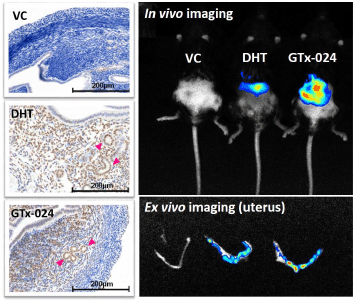| 014P Edinburgh, United Kingdom Pharmacology Futures 2018 – celebrating 250 years of pharmacology in Edinburgh |
Investigating SARMs as novel therapeutics in women
Introduction Androgens modulate key processes within the endometrium which are targets in the treatment of infertility, endometriosis and heavy menstrual bleeding (1). However the ubiquitous expression of androgen receptor (AR) has thus far limited its utility as a drug target in women due to side-effects. Selective Androgen Receptor Modulators (SARMs) are novel non-steroidal agents that bind in a tissue-selective manner without masculinizing effects in females. The aim of this study was to investigate the impact of SARMs on endometrial function.
Methods Using a mouse model, we have both defined the impact of the potent AR agonist DHT on uterine physiology (Simitsidellis et al 2016) and identified an androgenic ‘signature’ as a platform for assessment and comparison of SARM candidates. Eight to ten week-old mice (C57BL/6J) were ovariectomised to deplete endogenous steroids then administered with vehicle solution [VC; 0.4% methycellulose/5% ethanol] or the SARMs GTx-007 (Andarine;0.5mg) or GTx-024 (Ostarine; 0.5mg) subcutaneously, daily, for 7 days [N=7/treatment group]. Uteri were collected and analysed by qPCR and by immunohistochemistry with automated image analysis.
Results Treatment with GTx-024 but not GTx-007, significantly increased uterine weight as well as endometrial, stromal and glandular area compared to the control group (VC; n=7, p<0.05). GTx-024 significantly increased uterine AR expression in myometrial (n=7, p<0.01), stromal (n=7, p<0.01) and epithelial (n=7, p<0.01) cells compared to VC. GTx-024 treatment increased the absolute number of endometrial glands compared to VC or GTx-007 treatment (n=7, p<0.05). Gene expression analysis revealed GTx-024 altered expression of genes associated with stromal-epithelial interactions and proliferation/cell-cycle regulation including Igf1 (p<0.001), Mki67 (p<0.01) and Rb1 (p<0.01). AR activation by GTx-024 was confirmed using ARE-luciferase mice (2) and IVIS imaging system (figure 1).

Figure 1. AR activation by GTx-024. Uterine AR expression (brown stain) and activation of ARE-luciferase were increased by DHT or GTx-024.
Conclusion The impact of GTx-024 on the uterus mirrored that of DHT (3). SARMs offer a beneficial therapeutic strategy in women by targeting AR-dependent processes without undesirable masculinizing side-effects. Our data reveal distinct impacts of different SARMs (GTx-024, GTx-007) on the uterus. This study is the first to identify a role for SARMs in modulating endometrial function.
References
1. Simitsidellis I, Saunders PTK, Gibson DA. Mol Cell Endocrinol. 2017 Sep 15
2. Dart DA et al (2013) PLoS ONE 8(8): e71694
3. Simitisdellis I, Gibson DA et al (2016) Endocrinology.157(5):2116-28.

